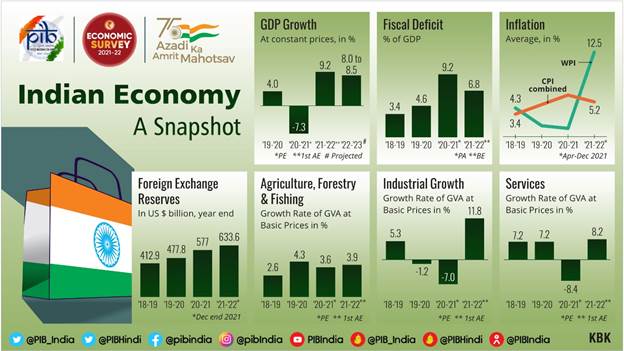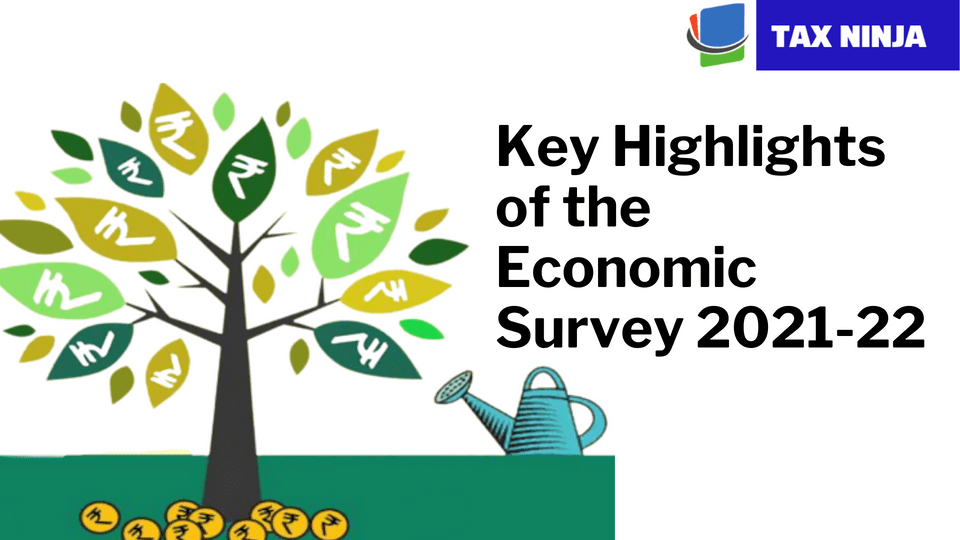The Union Minister for Finance & Corporate Affairs, Smt. Nirmala Sitharaman presented the Economic Survey 2021-22 in Parliament today.

The highlights of the Economic Survey are as follows:
State of the Economy:
- Indian economy estimated to grow by 9.2 percent in real terms in 2021-22 (as per first advanced estimates) subsequent to a contraction of 7.3 percent in 2020-21.
- GDP projected to grow by 8- 8.5 percent in real terms in 2022-23.
- The year ahead poised for a pickup in private sector investment with the financial system in good position to provide support for economy’s revival.
- Projection comparable with World Bank and Asian Development Bank’s latest forecasts of real GDP growth of 8.7 percent and 7.5 percent respectively for 2022-23.
- As per IMF’s latest World Economic Outlook projections, India’s real GDP projected to grow at 9 percent in 2021-22 and 2022-23 and at 7.1 percent in 2023-2024, which would make India the fastest growing major economy in the world for all 3years.
- Agriculture and allied sectors expected to grow by 3.9 percent; industry by 11.8 percent and services sector by 8.2 percent in 2021-22.
- On demand side, consumption estimated to grow by 7.0 percent, Gross Fixed Capital Formation (GFCF) by 15 percent, exports by 16.5 percent and imports by 29.4 percent in 2021-22.
- Macroeconomic stability indicators suggest that the Indian Economy is well placed to take on the challenges of 2022-23.
- Combination of high foreign exchange reserves, sustained foreign direct investment, and rising export earnings will provide adequate buffer against possible global liquidity tapering in 2022-23.
- Economic impact of “second wave” was much smaller than that during the full lockdown phase in 2020-21, though health impact was more severe.
Fiscal Developments:
- The revenue receipts from the Central Government (April to November, 2021) have gone up by 67.2 percent (YoY) as against an expected growth of 9.6 percent in the 2021-22 Budget Estimates (over 2020-21 Provisional Actuals).
- Gross Tax Revenue registers a growth of over 50 percent during April to November, 2021 in YoY terms. This performance is strong compared to pre-pandemic levels of 2019-2020 also.
- During April-November 2021, Capex has grown by 13.5 percent (YoY) with focus on infrastructure-intensive sectors.
- Sustained revenue collection and a targeted expenditure policy has contained the fiscal deficit for April to November, 2021 at 46.2 percent of BE.
- With the enhanced borrowings on account of COVID-19, the Central Government debt has gone up from 49.1 percent of GDP in 2019-20 to 59.3 percent of GDP in 2020-21, but is expected to follow a declining trajectory with the recovery of the economy.
External Sectors:
- India’s merchandise exports and imports rebounded strongly and surpassed pre-COVID levels during the current financial year.
- Net capital flows were higher at US$ 65.6 billion in the first half of 2021-22, on account of continued inflow of foreign investment, revival in net external commercial borrowings, higher banking capital and additional special drawing rights (SDR) allocation.
- India’s external debt rose to US $ 593.1 billion at end-September 2021, from US $ 556.8 billion a year earlier, reflecting additional SDR allocation by IMF, coupled with higher commercial borrowings.
- Foreign Exchange Reserves crossed US$ 600 billion in the first half of 2021-22 and touched US $ 633.6 billion as of December 31, 2021.
- As of end-November 2021, India was the fourth largest forex reserves holder in the world after China, Japan and Switzerland.
Monetary Management and Financial Intermediation:
- The liquidity in the system remained in surplus.
- Repo rate was maintained at 4 per cent in 2021-22.
- RBI undertook various measures such as G-Sec Acquisition Programme and Special Long-Term Repo Operations to provide further liquidity.
- The economic shock of the pandemic has been weathered well by the commercial banking system:
- YoY Bank credit growth accelerated gradually in 2021-22 from 5.3 per cent in April 2021 to 9.2 per cent as on 31st December 2021.
- The Gross Non-Performing Advances ratio of Scheduled Commercial Banks (SCBs) declined from 11.2 per cent at the end of 2017-18 to 6.9 per cent at the end of September, 2021.
- Net Non-Performing Advances ratio declined from 6 percent to 2.2 per cent during the same period.
- Capital to risk-weighted asset ratio of SCBs continued to increase from 13 per cent in 2013-14 to 16.54 per cent at the end of September 2021.
- The Return on Assets and Return on Equity for Public Sector Banks continued to be positive for the period ending September 2021.
- Exceptional year for the capital markets:
- Rs. 89,066 crore was raised via 75 Initial Public Offering (IPO) issues in April-November 2021, which is much higher than in any year in the last decade.
- Sensex and Nifty scaled up to touch peak at 61,766 and 18,477 on October 18, 2021.
- Among major emerging market economies, Indian markets outperformed peers in April-December 2021.
Prices and Inflation:
- The average headline CPI-Combined inflation moderated to 5.2 per cent in 2021-22 (April-December) from 6.6 per cent in the corresponding period of 2020-21.
- The decline in retail inflation was led by easing of food inflation.
- Food inflation averaged at a low of 2.9 per cent in 2021-22 (April to December) as against 9.1 per cent in the corresponding period last year.
- Effective supply-side management kept prices of most essential commodities under control during the year.
Sustainable Development and Climate Change:
- India’s overall score on the NITI Aayog SDG India Index and Dashboard improved to 66 in 2020-21 from 60 in 2019-20 and 57 in 2018-19.
- Number of Front Runners (scoring 65-99) increased to 22 States and UTs in 2020-21 from 10 in 2019-20.
- In North East India, 64 districts were Front Runners and 39 districts were Performers in the NITI Aayog North-Eastern Region District SDG Index 2021-22.
- India has the tenth largest forest area in the world. In 2020, India ranked third globally in increasing its forest area during 2010 to 2020.
- In 2020, the forests covered 24% of India’s total geographical, accounting for 2% of the world’s total forest area.
- In August 2021, the Plastic Waste Management Amendment Rules, 2021, was notified which is aimed at phasing out single use plastic by 2022.
- The Compliance status of Grossly Polluting Industries (GPIs) located in the Ganga main stem and its tributaries improved from 39% in 2017 to 81% in 2020.
- The consequent reduction in effluent discharge has been from 349.13 millions of litres per day (MLD) in 2017 to 280.20 MLD in 2020.
- The Prime Minister, as a part of the national statement delivered at the 26th Conference of Parties (COP 26) in Glasgow in November 2021, announced ambitious targets to be achieved by 2030 to enable further reduction in emissions.
- The need to start the one-word movement ‘LIFE’ (Lifestyle for Environment) urging mindful and deliberate utilization instead of mindless and destructive consumption was underlined.
Agriculture and Food Management:
- The Agriculture sector experienced buoyant growth in past two years, accounting for a sizeable 18.8% (2021-22) in Gross Value Added (GVA) of the country registering a growth of 3.6% in 2020-21 and 3.9% in 2021-22.
- Minimum Support Price (MSP) policy is being used to promote crop diversification.
- Net receipts from crop production have increased by 22.6% in the latest Situation Assessment Survey (SAS) compared to SAS Report of 2014.
Industry and Infrastructure:
- Index of Industrial Production (IIP) grew at 17.4 percent (YoY) during April-November 2021 as compared to (-)15.3 percent in April-November 2020.
- Capital expenditure for the Indian railways has increased to Rs. 155,181 crores in 2020-21 from an average annual of Rs. 45,980 crores during 2009-14 and it has been budgeted to further increase to Rs. 215,058 crores in 2021-22 – a five times increase in comparison to the 2014 level.
- Extent of road construction per day increased substantially in 2020-21 to 36.5 Kms per day from 28 Kms per day in 2019-20 – a rise of 30.4 percent.
- Net profit to sales ratio of large corporates reached an all-time high of 10.6 percent in in July-September quarter of 2021-22 despite the pandemic (RBI Study).
Services:
- Overall service Sector GVA is expected to grow by 8.2 percent in 2021-22.
- During the first half of 2021-22, service sector received over US$ 16.7 billion FDI – accounting for almost 54 percent of total FDI inflows into India.
- IT-BPM services revenue reached US$ 194 billion in 2020-21, adding 1.38 lakh employees during the same period.
- India has become 3rd largest start-up ecosystem in the world after US and China. Number of new recognized start-ups increased to over 14000 in 2021-22 from 733 in 2016-17.
- 44 Indian start-ups have achieved unicorn status in 2021 taking overall tally of unicorns to 83, most of which are in services sector.
Source : PIB


